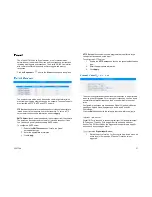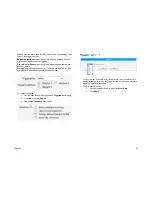
33023AA
31
IEEE 802.1X is an IEEE standard for port-based Network Access
Control. This requires network port devices to provide verification before
being allowed access to a protected network, usually in the form of a
username and password.
1. To enable IEEE802.1X, check the
Enabled
check box.
2. Designate an
EAPOL Version
.
3. Enter the desired
Username and Password
that will be used
for verified access to the network.
4. Upload
CA
or
User Certificate
, and
User Private Key
from
the RADIUS server.
5. Click
Apply.
After the configuration of IEEE 802.1X, you will be prompted to
Save and Reboot to apply the settings.
SNMP provides easy management of network devices. Features of
SNMP include monitoring device uptime, system detail description,
collection of interface information, and measuring network interface
throughput.
To modify SNMP settings:
1. Check the
Enabled
check box.
2. Modify settings appropriately.
3. Click
Apply.
SNMP V1 / V2:
uses “Community” name as password to authenticate
identity. “Read Community” is the password for server to get information
from devices. “Write Community” is the password for server to edit
values on devices.
SNMP V3:
uses account/password for authentication. “Security Name”:
is the account name to be used with your “Password” The default secuty
name is “public.”
SNMP Trap Usage:
SNMP trap enables notification from devices.
Notifications will be sent on cold start, warm start, and authentication
failure.
If RTP is enabled, then account name and password authentication will
be required for RTP streaming. Enabling RTP sends an additional B2
frame to every video frame, containing information such as motion
detection, digital input and output levels, frame counter, resolution,
timestamp, and more.
To modify RTP settings:
1. Check the
Enabled
check box.
2. Modify settings appropriately.
3. Click
Apply.



























